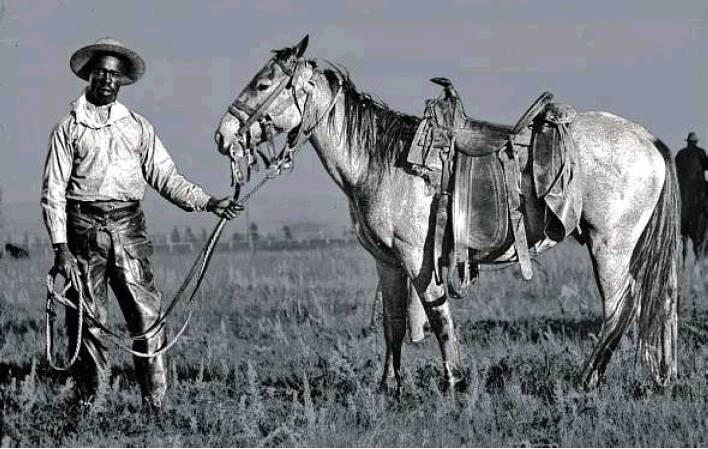Commentary
Witte exhibit gives Black cowboys their due
ELAINE AYALA
Before the Civil War, a quarter of Texas cowboys on cattle drives were Black.
Like their white and Tejano counterparts, they had a singular perspective.
It was on horseback, 7 feet up.
Some of those Black cowboys were free; some were enslaved. Other Black ranch hands, including women and children, stayed home taming horses, tending livestock and repairing equipment.
Together, they contributed to the development of the state’s cattle industry, which became one of the biggest in the nation. They’ve been neglected by history, but they’ve begun to receive their due in a fascinating new exhibit at the Witte Museum.
The show examines much more than what’s made obvious by its title, “Black Cowboys: An American Story.”
It reaches back to cattle herding in Africa, the vaquero traditions of New Spain and emancipation. It bridges past and present with stories and remarkable photographs of Black ranches and rodeos.
“Black Cowboys” tells us that before the Civil War, enslaved people made up 30 percent of the state’s population, and that during Reconstruction and into the early 20th century, Guadalupe County had 700 Black-owned ranches. It now has one.
Former slaves bought land and established freedom colonies for self-protection. They were threatened by the Ku Klux Klan and a judicial system that sanctioned seizures of their property.
The individual stories are illuminating. One involves a cowboy known only as Jack. He was enslaved and brought to Texas at age 8 in the 1830s by Samuel Maverick, the famed lawyer, politician, land baron and signer of the Texas Declaration of Independence.
A video introduces us to Hector Bazy, whose autobiographical account of breaking horses, branding cattle and cooking over a campfire was preserved in the 1930s by the Federal Writers Project. In a video, he’s portrayed by actor-playwright Eugene Lee.
Then there’s the story of a contemporary Black cowboy, Larry Callies, a stampede survivor who became a rodeo entertainer and country singer who opened for Selena, among others. He founded the Black Cowboy Museum in Rosenberg.
“Black Cowboys” is packed into just three small rooms at the Witte, but its impact is large.
It was the brainchild of San Antonio arts and civic leader Aaronetta Pierce, who serves as tri-chair of the Alamo Citizens Advisory Committee overseeing that landmark’s redevelopment.
There’s a connection between the Alamo and the Witte exhibit. Both involve the vital work of persuading a recalcitrant state to grapple with its history, both good and bad, and to recognize the important roles played by people of color.
This is where “Black Cowboys” makes its biggest contribution.
About 300 people attended a preview Monday, where co-curator Ron Davis, a Ph.D. candidate in history at the University of Texas at Austin, delivered the line that hung in the air all night: 1 in 4 Texas cowboys who participated in cattle drives before the Civil War were Black.
They and their Mexican, Tejano and Mexican American brothers and sisters weren’t the cowboys popularized by Hollywood.
Those cowboys were portrayed almost entirely as white men.
Davis, whose doctoral dissertation focuses on Black cowboys, underscored another interesting bit of history — about the origins of the word “cowboy.”
It was first used exclusively to describe Black cowboys. White men were more likely to be called, or to call themselves, “cattlemen” or “cowhands,” even into the late 19th century, Davis said.
The term “boy,” of course, was used by whites to demean adult Black men, largely in the South.
Few books have been devoted to Black cowboys and to slavery in Texas in general, Davis said.
He finds that telling, a mark of reluctance to deal with the legacy of slavery. It’s also “indicative of how Texans understand themselves,” he said.
It’s no surprise that many Texans, from the governor on down, have a hard time dealing with the Alamo’s history in a balanced way, insisting instead on an exclusively Anglo perspective steeped in myth.
After the Civil War, “there was a trend in Texas history to see itself as Western rather than Southern,” Davis said.
While Texas lawmakers attempt to keep alternate perspectives out of students’ reach, Davis says university students are “blown away” upon learning about Comanche power in Texas, the Mexican Revolution and the letters of Stephen F. Austin.
The latter show how important slavery was in populating the state and remaking it as an “Anglo Texas,” Davis said. Austin used land giveaways to draw white Southerners, who brought slaves with them.
The state’s economy was based on slavery.
“Black Cowboys: An American Story” is in its first phase. Officials expect the show will travel and grow.
“People are hungry to know more about the history they weren’t taught,” Davis said. “It’s a unique time to share with the public what historians have known for decades.”
He says it’s one of the first exhibits on the subject in the country.
Hollywood and Texas helped create one kind of hero.
“Black Cowboys” shows that there were many others, and that many of them were far more heroic.
The show runs through April. eayala@express-news.net

